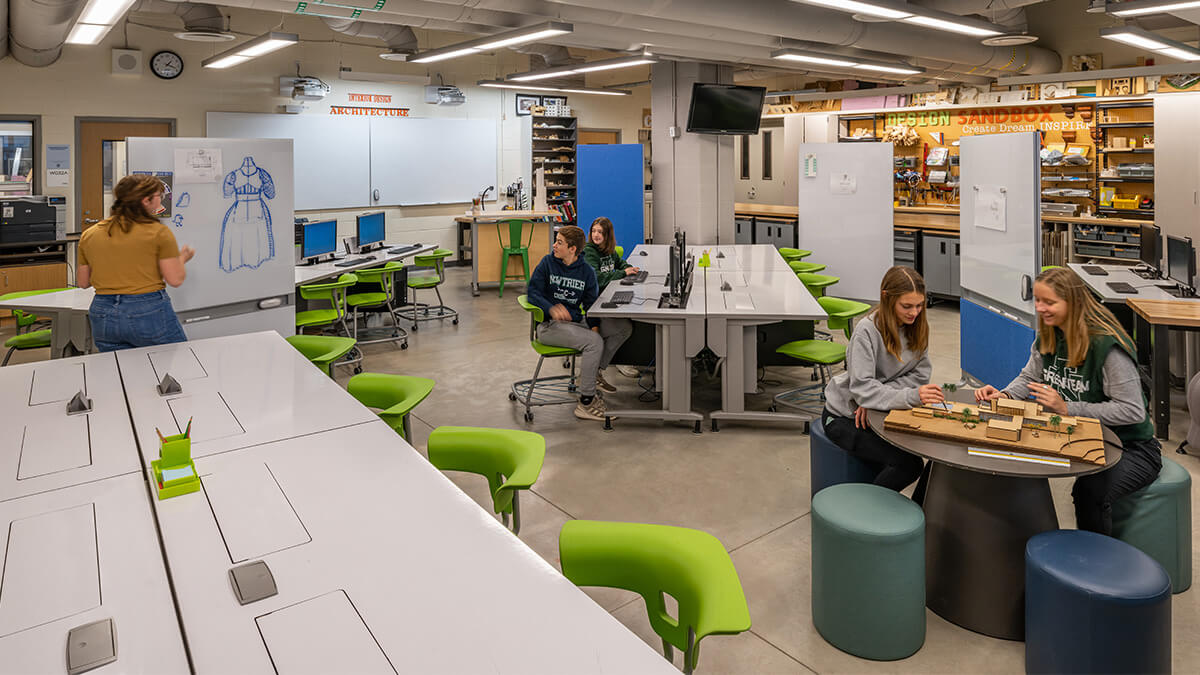- What's New
- Pricing & Purchasing
- Lead Times
- Literature & Samples
- Services & Warranties
- Careers
- Find a Rep
Teacher Nicole Hoiten Shares How to Engage Project-Based Learning

I recently penned an op-ed for the Dallas Morning News on the value of project-based learning for both students and teachers.
In my column, I wrote about how project-based learning can give teachers more flexibility at a time when many are considering leaving the profession. I also shared some interesting research on how this approach helps students learn, with students of all ages and socioeconomic backgrounds posting impressive outcomes.
But there’s one topic I didn’t have room to explore in my piece. How does a teacher implement a project-based learning model? In a forthcoming series of interviews, I’ll be speaking with several educators about their experiences with project-based learning.
My first conversation is with Nicole Hoiten, a middle-school math teacher in the Charlotte, N.C., area. She shared incredible insights from her experiences in the classroom and beyond.
This conversation has been lightly edited for clarity.
Emily McGinnis: Tell us about your background.
Nicole Hoiten: I’ve been a teacher for 12 years. I started out teaching second grade and then moved up to middle school. I initially taught all subjects, but when I moved to Charlotte, I got really into math. I’ve taught math and engineering for sixth grade through eighth grade, and I currently teach sixth grade math. I also work part-time in the Army National Guard. I’ve been in it for 19 years and am working my way up to being an officer soon.
Emily: What does project-based learning mean to you?
Nicole: To me, project-based learning is hands-on learning. It’s about kids—or learners anywhere—working together to figure out a solution without a teacher necessarily telling them. They’re working together to discover an approach to solve a problem.
Emily: What does that look like in your classroom? Do you typically give your students a problem to solve?
Nicole: I think you have to start out with the standard or concept you want them to learn. Then, you give them criteria that they can achieve to gain an understanding of the concept. Working to meet that criteria helps them get to a solution. Depending on the concept, it could take weeks. It could take a day. It could take 20 minutes.
Emily: What’s your role when the students are working on the project?
Nicole: Just to guide. Just to support, not to tell them anything. For one project I’ve done, the students had to build a prototype. I decided to incorporate math into it by acting as a cashier. Students "purchased" their items for their prototype, in addition to solving the problem.
Emily: Do you feel like a lot of project-based learning is based on real-life situations or scenarios? Is that important?
Nicole: Yes. Students do really great when it’s a made-up situation, but you want projects to be connected to something that would happen in the real world so they can relate to it and find a purpose in that learning.
Emily: What are the benefits of project-based learning for students?
Nicole: Collaboration is the biggest piece. Students are brainstorming and working together to come up with their ideas, rather than being given one single approach. Project-based learning allows students to think outside the box. They’re not just sitting and receiving information. They’re discovering and researching. They’re coming up with different solutions together.
Emily: How do your students respond to project-based learning as opposed to other teaching styles?
Nicole: They’re definitely more engaged. I’ve also found that when I have students peer-review or peer-grade at the end of a project, this approach holds them more accountable. They all have to hold their own and do their part.
I definitely think students grasp and understand concepts better, too. They’re gaining a more meaningful understanding, as opposed to just memorizing, reciting a lesson and moving on. They find a deeper purpose in learning and collaboration.
Emily: How easy or difficult is it to include project-based learning in your lesson planning?
Nicole: It has been difficult for me to plan for an all project-based learning model for multiple years in a row. That difficulty is largely a function of different administrations, changing colleagues, and most recently, COVID-19. A lot of my projects have been computer-based, and then I like to move the projects off the computer. It takes a lot to set up and find a good flow. Planning is the hardest part because it takes time to front-load everything. However, I know that it’s worth it.
Emily: How do you assess project-based learning? How do you assess students’ understanding or knowledge of what they’ve been learning?
Nicole: I incorporate rubrics along the way. A student’s final project -- whether it’s a presentation or a product they’ve made -- demonstrates their understanding. Peer evaluation gives me a lot of feedback as well.
Emily: What are some of the challenges students face with project-based learning?
Nicole: If project-based learning isn’t structured, it can be very chaotic and stressful for students and teachers. For some students, a lack of structure can be overwhelming. Take a week-long project. You don’t want to give students everything on the first day and just say, "Go." You want to have structure along the way, so students know they’re making progress. They can check in and make sure they’re understanding, versus waiting until the end and seeing that they failed. When it flows and it’s planned out well, it’s beautiful.
Another struggle could be if a student doesn’t get along well with their group members. Project-based learning can help them learn how to work with people and as part of a team.
Emily: Does project-based learning work better for some students than others?
Nicole: I think it works for everybody. I taught in a school where students collectively spoke 43 different languages. I would construct groups so that if a student didn’t speak English, they would work with English speakers. But for one project, I let four students who didn’t speak English work together. I gave them the expectations and they succeeded. They did great. So regardless of language or other abilities, I think project-based learning can work for anybody, so long as you have structure.
Emily: What are some of the challenges for teachers?
Nicole: Just the management piece, for sure. Planning takes work. It can be a challenge to make sure all students are getting their needs met because they’re moving at different paces. I’ve played around with pacing. Do we keep the students all together? Do we let them all fly on their own and meet up at the end? There are pros and cons to each.
Emily: What advice would you give a teacher who is new to project-based learning?
Nicole: Collaborate with a peer. Talk it out. Talk to teachers using project-based learning for other subject levels. I teach math, so I could work with the social studies teacher and find a way to make our lessons cross-disciplinary. Plan it together. In a small school, that can be really beneficial. It can excite kids, too. They’ll tell you, "Oh, we were talking about this in language arts, too!"
I also encourage my colleagues not to limit their students. If a teacher tends to gravitate towards having their students make a poster, I challenge that. Why can’t they do a song or rap?
The point is that the kids are thinking creatively. Some kids are more artsy, some are more mathematical. There are so many different intelligences. If you’re looking for a common concept to be met, it’s not helpful to limit the way in which it’s met. Giving students creative freedom is a key part of project-based learning. And it’s a huge advantage all around.
Practicing Project-Based Learning with Purpose
Collaboration, engagement and deeper understanding are just some of the positive outcomes Nicole has seen firsthand for her students when using project-based learning. With the right amount of structure, project-based learning can help students soar in the classroom and elevate excitement for teachers, too.
Stay tuned for our next conversation in our interview series with educators putting project-based learning into practice!
Subscribe
Stay up to date with the latest trends and more.








